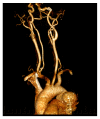Chronic Thoracic Aortic Aneurysm Presenting 29 Years following Trauma
- PMID: 26351610
- PMCID: PMC4550747
- DOI: 10.1155/2015/470917
Chronic Thoracic Aortic Aneurysm Presenting 29 Years following Trauma
Abstract
Blunt, nonpenetrating injuries of the thoracic aorta are uncommon and associated with a high mortality rate within the first hour. Aortic injury is missed in 1-2% of patients that survive to hospital, and a chronic thoracic aortic aneurysm may subsequently form. We present a case in which a chronic thoracic aortic aneurysm was diagnosed 29 years following a significant motor vehicle accident. We discuss the epidemiology, presentation, and management of this uncommon consequence of blunt, nonpenetrating aortic injury. Our case illustrates an important clinical lesson; a past medical history of trauma should not be overlooked at any patient assessment.
Figures




Similar articles
-
The role of contrast-enhanced spiral CT imaging versus chest X-rays in surgical therapeutic concepts and thoracic aortic injury: a 29-year Swiss retrospective analysis of aortic surgery.Cardiovasc J S Afr. 2005 May-Jun;16(3):162-5. Cardiovasc J S Afr. 2005. PMID: 16049590
-
Blunt aortic injury-traumatic aortic isthmus pseudoaneurysm with right iliac artery dissection aneurysm: A case report.World J Clin Cases. 2022 May 26;10(15):4998-5004. doi: 10.12998/wjcc.v10.i15.4998. World J Clin Cases. 2022. PMID: 35801016 Free PMC article.
-
Blunt thoracic aortic injury - concepts and management.J Cardiothorac Surg. 2020 Apr 19;15(1):62. doi: 10.1186/s13019-020-01101-6. J Cardiothorac Surg. 2020. PMID: 32307000 Free PMC article. Review.
-
Outcomes of thoracic endovascular aortic repair in patients with concomitant blunt thoracic aortic injury and traumatic brain injury from the Aortic Trauma Foundation global registry.J Vasc Surg. 2022 Mar;75(3):930-938. doi: 10.1016/j.jvs.2021.09.028. Epub 2021 Oct 1. J Vasc Surg. 2022. PMID: 34606963
-
Analysis of 46 intra-abdominal aortic injuries from blunt trauma: case reports and literature review.J Trauma. 1990 Oct;30(10):1294-7. doi: 10.1097/00005373-199010000-00017. J Trauma. 1990. PMID: 2213938 Review.
Cited by
-
Chronic Blunt Traumatic Thoracic Aortic Injuries: Report of three cases from Oman.Sultan Qaboos Univ Med J. 2021 Feb;21(1):e120-e123. doi: 10.18295/squmj.2021.21.01.017. Epub 2021 Mar 15. Sultan Qaboos Univ Med J. 2021. PMID: 33777433 Free PMC article.
References
-
- Demers P., Miller C., Mitchell R. S., Kee S. T., Chagonjian R. N. L., Dake M. D. Chronic traumatic aneurysms of the descending thoracic aorta: mid-term results of endovascular repair using first and second-generation stent-grafts. European Journal of Cardio-Thoracic Surgery. 2004;25(3):394–400. doi: 10.1016/j.ejcts.2003.11.035. - DOI - PubMed
LinkOut - more resources
Full Text Sources
Other Literature Sources
Miscellaneous

